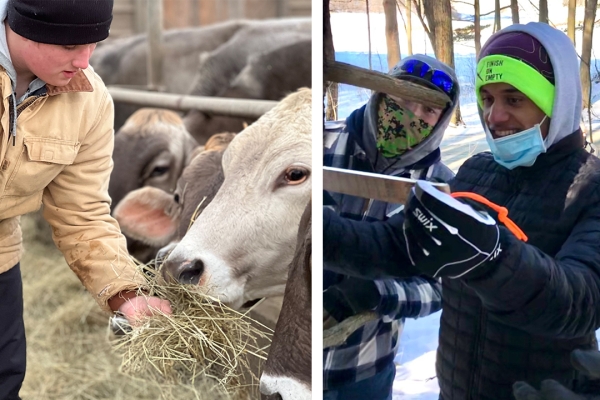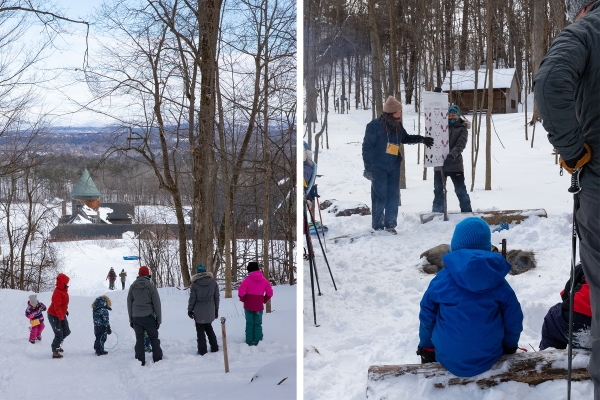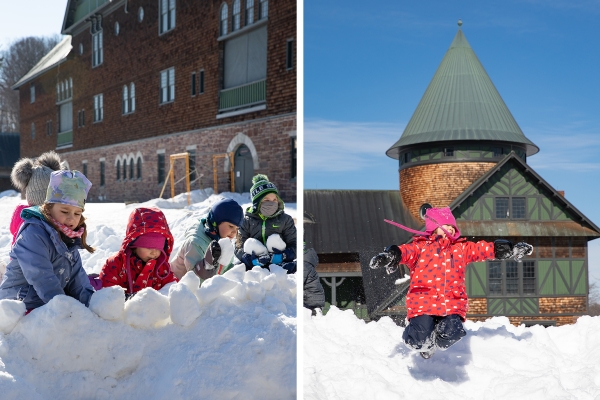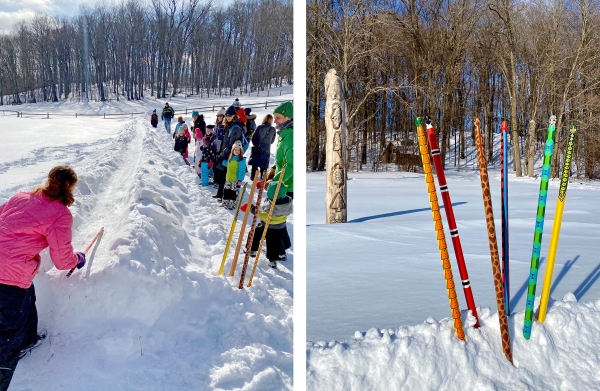What could be better than introducing kids and families to the original or historical caretakers of this amazing land for the last 10,000+ years I celebrate this beautiful form of inclusion! Bravo!
A Campus for Learning, Mid-Winter 2022
While some things lie dormant in cold weather, education hasn’t stopped for Shelburne Farms. Here are four ways people have learned on our farm and forest this winter.
CVU's Field and Forest Program
What better place to learn about fields and forests than on and around fields and forests? In this new semester-long program created and led by teachers at Champlain Valley Union High School, 20 students are spending Mondays from January to June building their understanding of social and ecological systems. Each lesson explores the connectedness of social justice, environment, climate, and literature using CVU’s campus, the farm, and beyond as classrooms.
Take, for example, one unit on land management. Students learned among the heifers from dairy farm manager Sam Dixon; in the forest with woodlands manager Dana Bishop; and on snowshoes with educators Courtney Mulcahy, Aimee Arandia Østensen, and Judy Dow, who discussed Indigenous Land perspectives and management. Questions came up about everything from grassland birds to water quality to forestry and sugaring in a warming climate. “It’s been great,” says CVU science teacher Dave Trevithick. “The more opportunities they have to see things, the more questions they have.” Field and Forest is inspired in part by Burlington City and Lake Semester.
Winter Wildlife Wander
Red fox tracks, squirrel caches, and rabbit-nibbled branches, oh my! These are just a few of the clues a group of families found on our recent Winter Wildlife Wander through our trails and woodlands. They started around a cozy campfire to learn the basics with educators Cat Parrish and Susie Marchand: which animals may be active in the winter, how different animals move, and what signs to look out for. Then, off to investigate!
Even though the fresh snow made clues a little more difficult to discover, there is always something interesting to find in the woods. “The most important part of looking for animal clues is to stay curious!” says Susie. “It’s exciting to follow a set of tracks and try to uncover the story behind them: Why would they stop by this stump? What are all these bark bits doing nearby? Did they climb up that tree? It’s all about building the story.”
“This program is one of my favorites,” shares Cat. “It warms up kids' (and grownups’!) eyes to the exciting things we can find in nature that often go unnoticed. And, you don’t have to come to Shelburne Farms to find animal signs. You can be a wildlife detective no matter where you are — walking on the sidewalk, hanging in your backyard, or playing in your schoolyard.”
Adventures Early Childhood Program
Snow and chilly temps don’t stop our preschool team from exploring the farm, trails, and woodlands! Some topics of discussion and discovery this season: snowflakes, maple sugaring, and the ideal form for sliding down snow piles.
And this group is putting their winter wildlife detective skills to work, too. “The kids' natural curiosity comes out when we’re looking for animal clues in familiar places that the group hasn't seen since the fall and before the snow cover, like the outdoor classroom or education garden,” explains Educator Jed Norris. “In the winter, we’re finding signs from foxes, voles, bobcats, coyotes, rabbits, squirrels, and owls, just to name a few.”
And not too long from now, warmer spring weather will offer lots of new ways to connect to nature: collecting sap, tasting fresh maple syrup, stomping through the mud, and finding the first patches of green grass!
Snow Snakes Family Program!
Sometimes learning at the farm has a light touch, spilling towards simple fun and laughter. At a recent family program, led by Abenaki Chief Don Stevens, families came out to discover and enjoy a traditional Indigenous game, called “Snow Snakes.” Each child pushed a colorfully decorated wooden stick (snake) down a snowy chute to see whose snake could go the furthest. (You can bet that parents joined in, too!) Educator Susie Marchand said, "Once each kid threw it, they just wanted to do it again and again. It was just so playful and fun."
The lessons of the day were uncomplicated, yet enduring: There is joy to be had in being outdoors whatever the season or temperature, and always new stories to learn from the people around you who call this place home. Educator Cat Parrish noted, "Families come out no matter how cold it is. How freakin' cool is that?"
Very cool.



